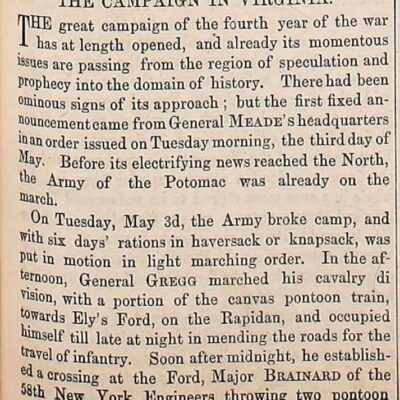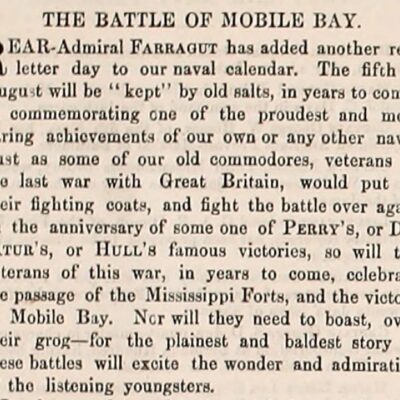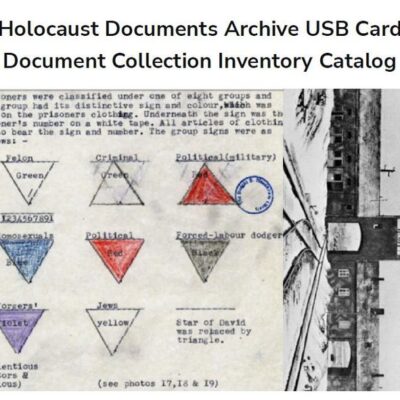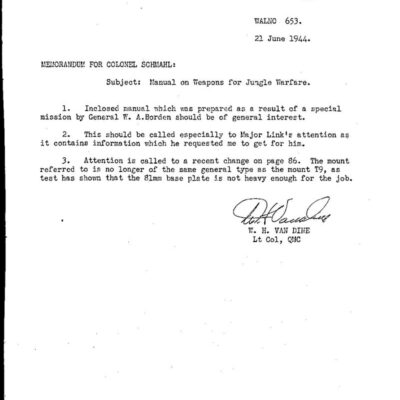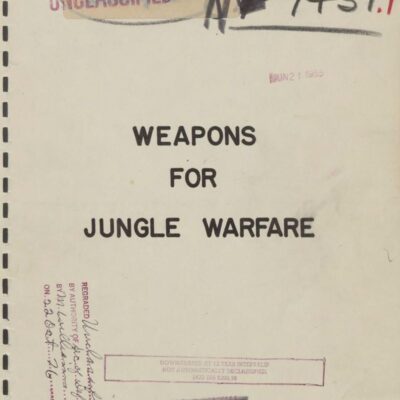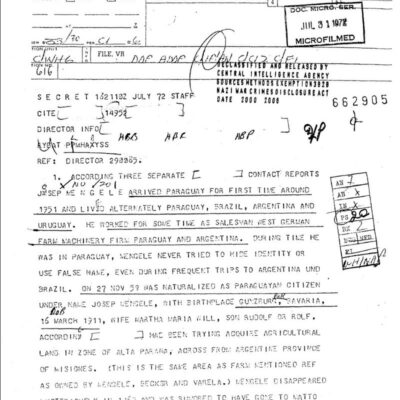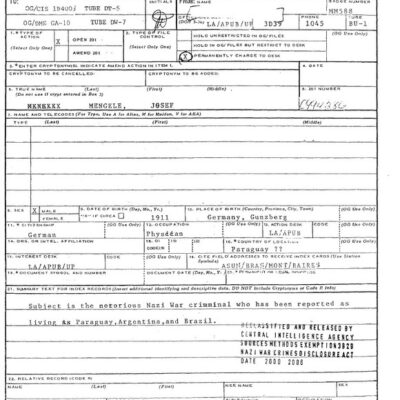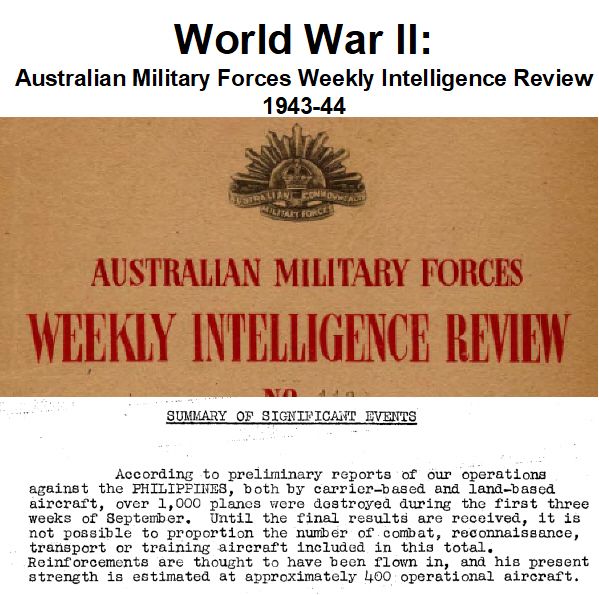
World War II: Australian Military Forces Weekly Intelligence Review 1943-44
$19.50
Description
Australian Military Intelligence: Pacific War Reviews 1943-1944
- March 19 – March 26, 1943: Compilation of intelligence data including enemy movements, operations by area, strength and dispositions of enemy forces, enemy organization, equipment, topography, and security. (Review Number 34)
- April 2 – April 9, 1943: Continued compilation of intelligence data on enemy movements, operations by area, strength and dispositions, organization, equipment, topography, and security. (Review Number 36)
- April 7 – April 14, 1944: Summary of significant events, operations by areas, enemy strengths and dispositions, organization, equipment, and tactics. Includes illustrations of a Japanese anti-vehicular “yardstick” mine and maps of Keaukwa area (Dutch New Guinea) and Waingapoe town area (shipping). (Review Number 89)
- April 29 – May 5, 1944: Summary of significant events, operations by areas, enemy strengths and dispositions, organization, equipment, and tactics. Includes an illustration of a Japanese water filter (“Ishii” type) and a map of the Burma situation. (Review Number 92)
- May 5 – May 12, 1944: Summary of significant events, operations by areas, enemy strengths and dispositions, organization, equipment, and tactics. Illustrations include a Japanese wireless set transmitter and receiver Type 94 Mk 36 Model “D” and details on Japanese Army distribution. (Review Number 93)
- May 12 – May 19, 1944: Summary of significant events, operations by areas, enemy strengths and dispositions, organization, equipment, and tactics. Illustrations include Vickers-Armstrong AA-Tk A gun, Allied landings in Wakde area, Japanese Army distribution of brigades and tank regiments, and Allied progress in the Southwest Pacific. (Review Number 94)
- May 19 – May 26, 1944: Summary of significant events, operations by areas, enemy strengths and dispositions, organization, equipment, tactics, and captured documents. Also covers “other fronts,” topography, and security. Appendices include details on Japanese 50mm flare/incendiary grenade, Sabang N. Sumatra photos, and enemy strengths in New Guinea (specifically for March 18, 1944). (Review Number 95)
- June 2 – June 9, 1944: Summary of significant events, operations by areas, enemy strengths and dispositions, organization, equipment, tactics, and captured documents. Covers other fronts, topography, and security. Appendices include the Japanese type 97 (1937) 90mm mortar and a map of Japanese mandated islands. (Review Number 97)
- June 16 – June 23, 1944: Summary of significant events, operations by areas, enemy strengths and dispositions, organization, equipment, tactics, and captured documents. Covers other fronts, topography, and security. Appendices include Japanese compass and clinometer, “A” type water filter, map of Allied operations in the Marianas Islands, and air distances to industrial Japan. (Review Number 99)
- June 30 – July 7, 1944: Summary of significant events, detailed land/sea/air operations, strengths and dispositions of enemy forces, organization, equipment, tactics, and captured documents. Covers other fronts, topography, and security. Appendices include Japanese armored cars and a perspective map of Burma operations to July 4, 1944. (Review Number 101)
- July 21 – July 28, 1944: Summary of significant events, detailed land/sea/air operations, strengths and dispositions of enemy forces, organization, equipment, tactics, and captured documents. Covers other fronts, topography, and security. Appendices include the Japanese 57mm Type 97 (1937) tank gun and a map of Allied operations in Guam. (Review Number 104)
- July 28 – August 4, 1944: Summary of significant events, detailed land/sea/air operations, strengths and dispositions of enemy forces, organization, equipment, tactics, and captured documents. Covers other fronts, topography, and security. Appendices include Japanese experimental self-projecting smoke candle, a perspective map of Europe, and information on the reorganization of the Japanese 31st Army. (Review Number 105)
- August 25 – September 1, 1944: Summary of significant events, detailed land/sea/air operations, strengths and dispositions of enemy forces, organization, equipment, tactics, and captured documents. Covers other fronts, topography, and security. Appendices include distribution of forces in South and Central Pacific, Japanese incendiary cluster hand grenade, defense of Tinian, submarines, bombardment of Saipan, and reorganization of forces in the Pacific area. (Review Number 109)
- September 22 – September 29, 1944: Summary of significant events, detailed land/sea/air operations, strengths and dispositions of enemy forces, organization, equipment, tactics, and captured documents. Covers other fronts, topography, and security. Appendices include Japanese 50mm smoke grenade, Japanese dummy installations, Japanese independent mixed brigades, and staff table for 68 Brigade units of the Karafuto Mixed Brigade. (Review Number 113)
- September 29 – October 6, 1944: Summary of significant events, detailed land/sea/air operations, strengths and dispositions of enemy forces, organization, equipment, tactics, and captured documents. Covers other fronts, topography, and security. Appendices include Japanese prefabricated assault bridge, a distance map of the Pacific Area, and “the Japanese Navy today.” (Review Number 114)
- October 6 – October 13, 1944: Summary of significant events, detailed land/sea/air operations, strengths and dispositions of enemy forces, organization, equipment, tactics, and captured documents. Covers other fronts, topography, and security. Appendices include Japanese water filter-ISHII type for section use, Japanese Island Warfare Division, and enemy strength on Bougainville and adjacent islands. (Review Number 115)
- October 13 – October 20, 1944: Summary of significant events, detailed land/sea/air operations, strengths and dispositions of enemy forces, organization, equipment, tactics, and captured documents. Covers other fronts, topography, and security. Appendices include a summary and estimate of enemy disposition and strengths in the Philippine Islands, Japanese rocket signal modification, a perspective map of the Philippine Islands, the Karafuto Mixed Brigade, and maps of the Philippine Islands. (Review Number 116)
- October 20 – October 27, 1944: Summary of significant events, detailed land/sea/air operations, strengths and dispositions of enemy forces, organization, equipment, tactics, and captured documents. Covers other fronts, topography, and security. Appendices include Japanese quick firing 37mm HE/incendiary shell, Japanese installations on Peleliu, and Japanese divisional establishments. (Review Number 117)
- November 3 – November 17, 1944: Summary of significant events, detailed land/sea/air operations, strengths and dispositions of enemy forces, organization, equipment, tactics, and captured documents. Covers other fronts, topography, and security. Appendices include Japanese “hoolamite” type carbon monoxide detector and Japanese booby traps. (Review Number 119)
Cast of Characters
The provided sources are intelligence reports focusing on military information (enemy forces, equipment, operations, etc.) and do not mention specific individuals or “characters” by name. The principal entities mentioned are military forces and intelligence organizations.
- Australian Commonwealth Military Forces’ Directorate of Military Intelligence (DMI): The organization responsible for compiling and publishing the “Weekly Intelligence Review” reports. Their role is to gather, analyze, and disseminate intelligence regarding enemy movements, operations, and capabilities.
- Japanese Army: The primary opposing ground force frequently analyzed in the intelligence reports, with details on their organization, equipment, tactics, strengths, and dispositions across various operational areas (e.g., New Guinea, Burma, Marianas, Philippines).
- Japanese Navy: The naval component of the enemy forces, with reports occasionally referencing their activities and current status (e.g., “the Japanese Navy today”).
- Allied Forces: The collective term for the military forces allied with Australia (e.g., US forces), often mentioned in the context of their operations and progress (e.g., “Allied landings Wakde area,” “Allied progress in the Southwest Pacific,” “Allied operations- Marianas Islands,” “Allied operations Guam”).
Note: As these are intelligence summaries, they focus on broad military entities and equipment rather than individual commanders or specific historical figures.
World War II: Australian Military Forces Weekly Intelligence Review 1943-44
577 pages of Australian Military Forces Weekly Intelligence Review. Twenty-One issues published between March 26, 1943, to November 17, 1944, published by the Australian Commonwealth Military Forces’ Directorate of Military Intelligence (DMI).
The reports contain compilation of data, illustrations, and detailed summaries covering: enemy movements, operations by area, strength and dispositions of enemy forces, enemy organization, enemy equipment, topography, security, and more.
Issues/Contents
Australian Military Forces Weekly Intelligence Review Number 34
Compilation of data received from 19 Mar 43 to 26 Mar 43 that provides detailed summaries of the following information: enemy movements, operations by area, strength and dispositions of enemy forces, enemy organization, enemy equipment, topography, and security. Includes appendices
Australian Military Forces Weekly Intelligence Review Number 36
Compilation of data received from 2 Apr 43 to 9 Apr 43 that provides detailed summaries of the following information: enemy movements, operations by area, strength and dispositions of enemy forces, enemy organization, enemy equipment, topography, and security. Includes appendices.
Australian Military Forces Weekly Intelligence Review Number 89
Compiled from information received from 1200 hours 7 April 1944 to 1200 hours 14 April 1944. Table of contents: summary of significant events; summary of operations by areas; strengths and dispositions of enemy forces; enemy organization; enemy equipment; tactics; comments on captured documents; and appendices. Illustrations include: Japanese anti-vehicular “yardstick” mine; Keaukwa area, Dutch New Guinea looking east; and Waingapoe town area (shipping)
Australian Military Forces Weekly Intelligence Review Number 91
Contents: summary of significant events; summary of operations by areas; strengths and dispositions of enemy forces; enemy organization; enemy equipment; comments on captured documents; and Japanese 75mm incendiary shell. Illustrations include sketches detailing Hollandia landings and a provisional map of Hollandia Dutch New Guinea.
Australian Military Forces Weekly Intelligence Review Number 92
Compiled from information received from 1200 hours 29 April 1944 to 1200 hours 5 May 1944. Table of contents: summary of significant events; summary of operations by areas; strengths and dispositions of enemy forces; enemy organization; enemy equipment; tactics; comments on captured documents; and appendices. Also includes an illustration of a Japanese water filter (“Ishii” type) and a map of the Burma situation compiled from information received to 3 May 1944.
Australian Military Forces Weekly Intelligence Review Number 93
Compiled from information received from 1200 hours 5 May 1944 to 1200 hours 12 May 1944. Table of contents: summary of significant events; summary of operations by areas; strengths and dispositions of enemy forces; enemy organization; enemy equipment; tactics; comments on captured documents; and appendices. Also includes illustrations of a Japanese wireless set transmitter and receiver type 94 Mk 36 model “D” and a page detailing Japanese Army distribution of armies and divisions.
Australian Military Forces Weekly Intelligence Review Number 94
Compiled from information received from 1200 hours 12 May 1944 to 1200 hours 19 May 1944. Table of contents: summary of significant events; summary of operations by areas; strengths and dispositions of enemy forces; enemy organization; enemy equipment; tactics; comments on captured documents; and appendices. Four illustrations include the following: 40 mm twin and single barrel “Vickers-Armstrong” AA-Tk A gun; Allied landings Wakde area; Japanese Army distribution of independent mixed brigades and infantry brigades, and tank regiments; and Allied progress in the Southwest Pacific.
Australian Military Forces Weekly Intelligence Review Number 95
Compiled from information received from 1200 hours 19 May 1944 to 1200 hours 26 May 1944. Part I: summary of significant events. Part II: summary of operations by areas; strengths and dispositions of enemy forces; enemy organization; enemy equipment; tactics; and comments on captured documents. Part III: other fronts. Part IV: topographical. Part V: security. Appendices: Japanese 50mm flare or incendiary grenade; Sabang N. Sumatra (official U.S. Navy photos); and enemy strengths- New Guinea, dispositions, and strength- Japanese forces, eastern New Guinea 18 March 1944.
Australian Military Forces Weekly Intelligence Review Number 97
Compiled from information received from 1200 hours 2 June 1944 to 1200 hours 9 June 1944. Part I: summary of significant events. Part II: summary of operations by areas; strengths and dispositions of enemy forces; enemy organization; enemy equipment; tactics; and extracts from captured documents. Part III: other fronts. Part IV: topographical. Part V: security. Appendices: Japanese type 97 (1937) 90 mm mortar, and map showing strengths, Japanese mandated islands.
Australian Military Forces Weekly Intelligence Review Number 99
Compiled from information received from 1200 hours 16 June 1944 to 1200 23 June 1944. Part I: summary of significant events. Part II: summary of operations by areas; strengths and dispositions of enemy forces; enemy organization; enemy equipment; tactics; extracts from captured documents; and general. Part III: other fronts. Part IV: topographical. Part V: security. Appendices: Japanese compass and clinometer “A” type water filter, map showing Allied operations- Marianas Islands, and map- air distances to industrial Japan.
Australian Military Forces Weekly Intelligence Review Number 101
Compiled from information received from 1200 hours 30 June 1944 to 1200 hours 7 July 1944. Part I: summary of significant events. Part II: summary of operations by areas (land/sea/air); strengths and dispositions of enemy forces (land/sea/air); enemy organization; enemy equipment; tactics; extracts from captured documents; and general. Part III: other fronts. Part IV: topographical. Part V: security. Appendices: Japanese armored cars, and perspective map of Burma operations to 4 July 1944
Australian Military Forces Weekly Intelligence Review Number 104
Compiled from information received from 1200 hours 21 July 1944 to 1200 hours 28 July 1944. Part I: summary of significant events. Part II: summary of operations by areas (land/sea/air); strengths and dispositions of enemy forces (land/sea/air); enemy organization; enemy equipment; tactics; extracts from captured documents; and general. Part III: other fronts. Part IV: topographical. Part V: security. Appendices: Japanese 57 mm (2.24 in.) type 97 (1937) tank gun, and map- Allied operations Guam
Australian Military Forces Weekly Intelligence Review Number 105
Compiled from information received from 1200 hours 28 July 1944 to 1200 hours 4 August 1944. Part I: summary of significant events. Part II: summary of operations by areas (land/sea/air); strengths and dispositions of enemy forces (land/sea/air); enemy organization; enemy equipment; tactics; extracts from captured documents; and general. Part III: other fronts. Part IV: topographical. Part V: security. Appendices: Japanese experimental self-projecting smoke candle; perspective map of Europe; and reorganization of 31 Army
Australian Military Forces Weekly Intelligence Review Number 109
Compiled from information received from 1200 hours 25 August 1944 to 1200 hours 1 September 1944. Part I: summary of significant events. Part II: summary of operations by areas (land/sea/air); strengths and dispositions of enemy forces (land/sea/air); enemy organization; enemy equipment; tactics; extracts from captured documents; and general. Part III: other fronts. Part IV: topographical. Part V: security. Appendices: distribution of forces in South and Central Pacific; Japanese incendiary cluster hand grenade; defense of Tinian; submarines; bombardment broke Saipan; and reorganization of forces in the Pacific area.
Australian Military Forces Weekly Intelligence Review Number 113
Compiled from information received from 1200 hours 22 September 1944 to 1200 hours 29 September 1944. Part I: summary of significant events. Part II: summary of operations by areas (land/sea/air); strengths and dispositions of enemy forces (land/sea/air); enemy organization; enemy equipment; tactics; extracts from captured documents; and general. Part III: other fronts. Part IV: topographical. Part V: security. Appendices: Japanese 50mm smoke grenade; Japanese dummy installations; Japanese independent mixed brigades; and staff table for 68 brigade units of the Karafuto mixed brigade.
Australian Military Forces Weekly Intelligence Review Number 114
Compiled from information received from 1200 hours 29 September 1944 to 1200 hours 6 October 1944. Part I: summary of significant events. Part II: summary of operations by areas (land/sea/air); strengths and dispositions of enemy forces (land/sea/air); enemy organization; enemy equipment; tactics; extracts from captured documents; and general. Part III: other fronts. Part IV: topographical. Part V: security. Appendices: Japanese prefabricated assault bridge; distance map- Pacific Area; and the Japanese Navy today.
Australian Military Forces Weekly Intelligence Review Number 115
Compiled from information received from 1200 hours 25 August 1944 to 1200 hours 6 October to 1200 hours 13 October 1944. Part I: summary of significant events. Part II: summary of operations by areas (land/sea/air); strengths and dispositions of enemy forces (land/sea/air); enemy organization; enemy equipment; tactics; extracts from captured documents; and general. Part III: other fronts. Part IV: topographical. Part V: security. Appendices: Japanese water filter- ISHII type for section use; Japanese Island Warfare Division; and enemy strength- Bougainville and adjacent islands.
Australian Military Forces Weekly Intelligence Review Number 116
Compiled from information received from 1200 hours 13 October 1944 to 1200 hours 20 October 1944. Part I: summary of significant events. Part II: summary of operations by areas (land/sea/air); strengths and dispositions of enemy forces (land/sea/air); enemy organization; enemy equipment; tactics; extracts from captured documents; and general. Part III: other fronts. Part IV: topographical. Part V: security. Appendices: summary of enemy disposition in the Philippine Islands; estimate of enemy situation strengths in the Philippine Islands; Japanese rocket signal- modification 1; perspective map of the Philippine Islands; Karafuto Mixed Brigade; and maps of the Philippine Islands.
Australian Military Forces Weekly Intelligence Review Number 117
Compiled from information received from 1200 hours 20 October 1944 to 1200 hours 27 October 1944. Part I: summary of significant events. Part II: summary of operations by areas (land/sea/air); strengths and dispositions of enemy forces (land/sea/air); enemy organization; enemy equipment; tactics; extracts from captured documents; and general. Part III: other fronts. Part IV: topographical. Part V: security. Appendices: Japanese quick firing 37mm (1.4 in) HE/incendiary shell; Japanese installations on Peleliu; and Japanese divisional establishments.
Australian Military Forces Weekly Intelligence Review Number 119
Compiled from information received from 1200 hours 3 November 1944 to 1200 hours [17] November 1944. Part I: summary of significant events. Part II: summary of operations by areas (land/sea/air); strengths and dispositions of enemy forces (land/sea/air); enemy organization; enemy equipment; tactics; extracts from captured documents; and general. Part III: other fronts. Part IV: topographical. Part V: security. Appendices: Japanese “hoolamite” type carbon monoxide detector and Japanese booby traps.
